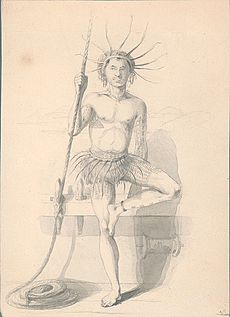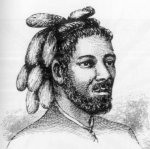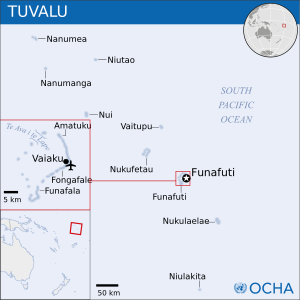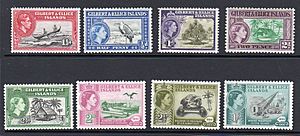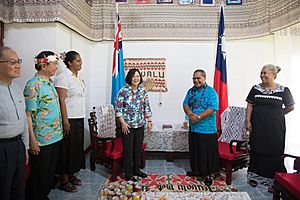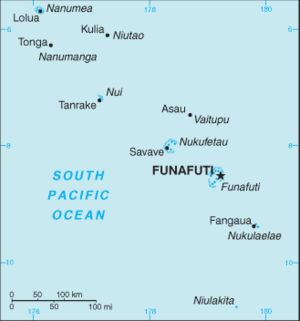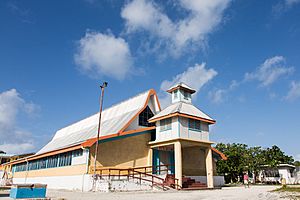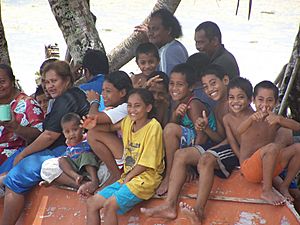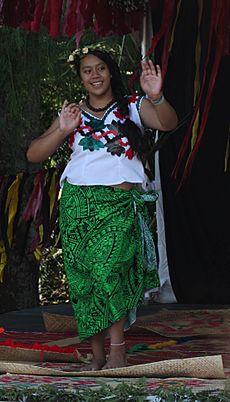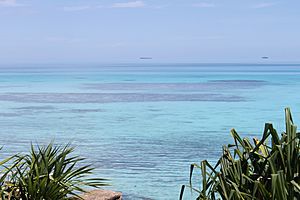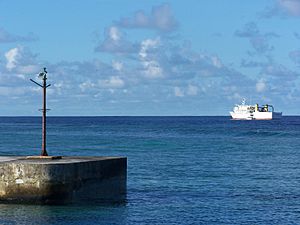Tuvalu facts for kids
Quick facts for kids
Tuvalu
|
|
|---|---|
|
|
|
|
Anthem: Tuvalu mo te Atua (Tuvaluan)
Tuvalu for the Almighty |
|
 |
|
| Capital and largest city
|
Funafuti 8°31′S 179°12′E / 8.517°S 179.200°E |
| Official languages | |
| Ethnic groups
(2022)
|
|
| Religion
(2022)
|
|
| Demonym(s) | Tuvaluan |
| Government | Unitary parliamentary constitutional monarchy |
|
• Monarch
|
Charles III |
| Tofiga Vaevalu Falani | |
| Feleti Teo | |
| Legislature | Parliament |
| Independence | |
|
• from the United Kingdom
|
1 October 1978 |
| Area | |
|
• Total
|
26 km2 (10 sq mi) (192nd) |
|
• Water (%)
|
negligible |
| Population | |
|
• 2021 estimate
|
11,900 (194th) |
|
• 2017 census
|
10,645 |
|
• Density
|
475.88/km2 (1,232.5/sq mi) (27th) |
| GDP (PPP) | 2023 estimate |
|
• Total
|
|
|
• Per capita
|
|
| GDP (nominal) | 2023 estimate |
|
• Total
|
|
|
• Per capita
|
|
| Gini (2010) | medium |
| HDI (2021) | medium · 130th |
| Currency |
|
| Time zone | UTC+12 |
| Driving side | left |
| Calling code | +688 |
| ISO 3166 code | TV |
| Internet TLD | .tv |
Tuvalu (pronounced too-VAH-loo or TOO-və-loo) is a small island country in the Pacific Ocean. It is part of Polynesia, a group of islands in Oceania. Tuvalu is located about halfway between Hawaii and Australia.
This country is made up of three reef islands and six atolls. An atoll is a ring-shaped coral reef, island, or chain of islands that surrounds a lagoon. These islands are spread out and lie west of the International Date Line. Tuvalu has a population of about 10,507 people (2017 census). The total land area is only 26 square kilometers (10 square miles), making it one of the smallest countries in the world.
The first people to live in Tuvalu were Polynesians. They traveled by canoe across the Pacific Ocean about 3,000 years ago. These skilled sailors used large canoes to explore and settle new islands. Scholars believe Polynesians from Samoa and Tonga first settled in Tuvalu. From there, they moved to other islands in Melanesia and Micronesia.
In 1568, a Spanish sailor named Álvaro de Mendaña de Neira was the first European to see Tuvalu. He spotted the island of Nui. Later, in 1819, the island of Funafuti was named Ellice's Island. Eventually, the whole group of islands became known as the Ellice Islands. In the late 1800s, Great Britain took control of the Ellice Islands. They became a British protectorate in 1892. From 1916 to 1975, they were part of the Gilbert and Ellice Islands colony.
In 1974, people in the Ellice Islands voted to have their own government, separate from the Gilbert Islands. This led to the creation of two separate British colonies: Kiribati and Tuvalu. On October 1, 1978, Tuvalu became a fully independent country. It joined the Commonwealth of Nations. On September 5, 2000, Tuvalu became the 189th member of the United Nations.
Tuvalu does not have much soil, so it depends on imported food and fishing. Fishing and tourism are important parts of its economy. Because it is a small, low-lying island nation, Tuvalu is very sensitive to sea level rise caused by climate change. It actively participates in international talks about climate change.
History of Tuvalu
Early People and Myths
The first people of Tuvalu were Polynesians who arrived around 3,000 years ago. They often traveled by canoe between nearby islands like Samoa and Tonga. Eight of Tuvalu's nine islands were settled. This is why the name Tuvalu means "eight standing together" in the Tuvaluan language. Some evidence suggests humans might have lived on the islands for thousands of years.
A famous story in Tuvalu is about te Pusi mo te Ali (the Eel and the Flounder). They are believed to have created the islands. Te Ali (the flounder) is said to be the origin of Tuvalu's flat atolls. Te Pusi (the eel) is the model for the coconut palms, which are very important to Tuvaluan life.
First European Visitors
Europeans first saw Tuvalu on January 16, 1568. A Spanish explorer named Álvaro de Mendaña sailed past Nui. He named it Isla de Jesús. He met the islanders but could not land. Later, in 1595, he passed Niulakita.
In 1764, Captain John Byron sailed through Tuvalu. He called the islands Lagoon Islands. In 1819, American captain Arent Schuyler de Peyster named Nukufetau and Funafuti as Ellice's Island. He named them after Edward Ellice, a British politician. Later, all nine islands were called the Ellice Islands.
Whalers and Missionaries
Whalers began sailing the Pacific in the 1800s. They did not visit Tuvalu often because it was hard to land on the atolls. The first whaler to visit was Captain George Barrett in 1821. He traded coconuts with people on Nukulaelae and also visited Niulakita.
Between 1862 and 1863, Peruvian ships took many islanders to work in Peru. Some islanders went willingly, but many were tricked or kidnapped. This practice was called "blackbirding." About 170 people were taken from Funafuti and 250 from Nukulaelae.
Christianity arrived in Tuvalu in 1861. A deacon named Elekana from the Cook Islands drifted to Nukulaelae after a storm. He began teaching Christianity. In 1865, the first European missionary, Rev. A. W. Murray, arrived. By 1878, Christianity was well established on every island. Samoan ministers greatly influenced the Tuvaluan language and music of Tuvalu.
Becoming a British Protectorate
In the late 1800s, Britain gained control over the Ellice Islands. Captain Gibson of HMS Curacoa declared each island a British protectorate between October 9 and 16, 1892. This meant Britain would protect and govern the islands.
Trading and Early Visitors
Trading companies became active in Tuvalu in the mid-1800s. They hired European traders to live on the islands. John O'Brien was the first European to settle in Tuvalu in the 1850s. He became a trader on Funafuti.
Many explorers and scientists visited Tuvalu.
- The United States Exploring Expedition visited Funafuti, Nukufetau, and Vaitupu in 1841.
- In 1890, writer Robert Louis Stevenson and his family visited some of the Ellice Islands.
- In 1894, Count Rudolf Festetics de Tolna took many photos of people on Funafuti.
- Scientists from the Royal Society of London drilled into the coral on Funafuti in the late 1890s. They wanted to study how coral reefs form.
World War II in Tuvalu
During World War II, the Ellice Islands sided with the Allies. The United States Marine Corps landed on Funafuti in October 1942. They also landed on Nanumea and Nukufetau in August 1943.
Funafuti became an important base for attacks on Japanese-held islands in Kiribati. Islanders helped American forces build airfields on Funafuti, Nanumea, and Nukufetau. They also helped unload supplies. After the war, the airfield on Funafuti became the Funafuti International Airport.
Path to Independence
After World War II, the United Nations began a process to help colonies become independent. In 1974, the Gilbert and Ellice Islands Colony held a vote. The people decided that the two island groups should have their own governments.
On October 1, 1975, Tuvalu became a separate British territory. On January 1, 1976, it formed its own government. Elections were held in 1977. Toaripi Lauti became the Chief Minister. On October 1, 1978, Tuvalu became a fully independent nation, with Toaripi Lauti as its first Prime Minister. This day is celebrated as Tuvalu's Independence Day.
Geography and Environment
Islands and Land Area

Tuvalu is made of three reef islands and six true atolls. These are Nanumanga, Niutao, Niulakita, Funafuti, Nanumea, Nui, Nukufetau, Nukulaelae, and Vaitupu. It is a very small country, with a total land area of only 26 square kilometers (10 square miles). This makes it the fourth smallest country in the world.
The highest point in Tuvalu is only 4.6 meters (15 feet) above sea level, found on Niulakita. Over 40 years, the land area of Tuvalu's islets has actually increased by 2.9%. This happens because rising sea levels can move sand, adding to the island shorelines. However, the sea level at Funafuti has risen by 3.9 mm per year, which is twice the global average.
Funafuti is the largest atoll. It has many small islets around a central lagoon. The lagoon is about 25.1 km (15.6 mi) long and 18.4 km (11.4 mi) wide. Tuvalu's waters are home to many fish species. A study in 2010 found 317 fish species, with 66 new ones, bringing the total to 607. Tuvalu's special economic zone for fishing covers about 900,000 square kilometers (347,492 square miles).
Environmental Challenges
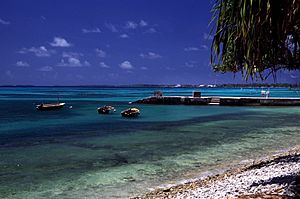
During World War II, the eastern shore of Funafuti Lagoon was changed to build an airfield. Coral was used to fill in areas for the runway. This created large holes that affected the fresh water underground. In low-lying areas of Funafuti, seawater can bubble up through the coral rock during high tide. In 2014, a project began to fill 10 of these holes with sand from the lagoon. This project, funded by New Zealand, increased the usable land on Fongafale by 8%.
The reefs at Funafuti were damaged by El Niño events between 1998 and 2001. Many corals turned white and died because of warmer ocean temperatures. Projects are now trying to restore the reefs.
The growing population puts pressure on fish stocks. The Funafuti Conservation Area helps protect fish populations. Pollution from waste and poor sanitation is also a problem. New laws and projects are working to improve waste management and reduce plastic waste.
Tuvalu's Climate
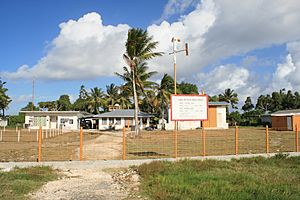
Tuvalu has two main seasons: a wet season from November to April and a dry season from May to October. From October to March, the weather is often windy with heavy rain. From April to November, tropical temperatures are made milder by easterly winds.
Tuvalu is affected by El Niño and La Niña. El Niño increases the chance of tropical storms and cyclones. La Niña increases the chance of drought. Tuvalu usually gets between 200 to 400 mm (7.9 to 15.7 inches) of rain each month.
| Climate data for Tuvalu | |||||||||||||
|---|---|---|---|---|---|---|---|---|---|---|---|---|---|
| Month | Jan | Feb | Mar | Apr | May | Jun | Jul | Aug | Sep | Oct | Nov | Dec | Year |
| Mean daily maximum °C (°F) | 31 (87) |
30 (86) |
30 (86) |
31 (87) |
31 (87) |
30 (86) |
30 (86) |
30 (86) |
30 (86) |
31 (87) |
31 (87) |
31 (87) |
30.3 (86.5) |
| Mean daily minimum °C (°F) | 27 (81) |
27 (81) |
27 (81) |
27 (81) |
28 (82) |
27 (81) |
27 (81) |
27 (81) |
27 (81) |
27 (81) |
27 (81) |
27 (81) |
26.9 (80.5) |
| Average precipitation mm (inches) | 390 (15.3) |
350 (13.9) |
310 (12.4) |
250 (10) |
240 (9.3) |
240 (9.3) |
260 (10.4) |
250 (9.8) |
230 (9.1) |
270 (10.5) |
280 (10.9) |
390 (15.5) |
3,500 (137.7) |
| Source: Weatherbase | |||||||||||||
Climate Change Impact
Tuvalu's low-lying islands are very sensitive to changes in sea level and strong storms. The highest point in Tuvalu is only 4.6 meters (15 feet) above sea level. Tuvaluan leaders are worried about rising sea levels. Some predict that a rise of 20–40 centimeters (8–16 inches) in the next 100 years could make Tuvalu hard to live in.
However, a 2018 study found that 75% of Tuvalu's islands have actually grown in size between 1971 and 2014. This is due to sand moving around. Despite this, Tuvalu's Prime Minister, Enele Sopoaga, has said that Tuvalu is not expanding and that moving people from the islands is a last resort.
Sea level rise is a big concern for Tuvaluans. They have seen changes like seawater bubbling up through the coral rock during high tides. Also, low-lying areas, including the airport, flood during very high tides called king tides.
Cyclones and King Tides
Tropical Cyclones

Because Tuvalu is so low, its islands are easily affected by tropical cyclones. A warning system was put in place in 2016 to help outer islands prepare for natural disasters.
The highest parts of the islands are usually narrow sand dunes on the ocean side. These can be flooded during cyclones. For example, Cyclone Bebe in October 1972 flooded Funafuti. It destroyed 90% of the buildings and contaminated drinking water.
Tuvalu used to have about three cyclones per decade. But in the 1980s, there were eight. The impact of a cyclone depends on its strength and if it hits during a high tide. Cyclone Meli in 1979 destroyed Tepuka Vili Vili islet, washing away all its plants and most of its sand.
In March 2015, Cyclone Pam caused waves of 3 to 5 meters (10 to 16 feet) to break over the reefs. This damaged homes, crops, and buildings. A state of emergency was declared. On Nui, fresh water sources were destroyed or polluted. Many families had to go to evacuation centers. The Tuvalu government and international groups helped with recovery efforts.
King Tides
Tuvalu is also affected by perigean spring tides, known as king tides. These tides are much higher than normal high tides. The highest tide recorded was 3.4 meters (11 feet) in 2006 and 2015. Because of rising sea levels, king tides cause flooding in low-lying areas. This flooding gets worse when combined with La Niña effects or local storms.
Water and Sanitation
The main source of fresh water in Tuvalu is collected rainwater. Some islands, like Nukufetau, Vaitupu, and Nanumea, also have underground water supplies. However, rainwater collection is often not as good as it could be because roofs, gutters, and pipes are not well maintained. Aid programs from Australia and the European Union are helping to improve water storage.
On Funafuti, reverse osmosis (R/O) plants make fresh water from seawater. This water is used when rainwater supplies are low. The government helps pay for this water, as it costs more to produce and deliver than what people pay.
In 2012, Tuvalu created a plan to improve access to safe drinking water and sanitation. This plan aims for each person to have 50 to 100 liters of water per day for drinking, cleaning, and other activities. Tuvalu is also working to use composting toilets and improve how sewage is treated. This helps prevent pollution of underground fresh water and the ocean.
Government and Law
How Tuvalu is Governed
Tuvalu's Constitution is the highest law. It protects people's basic rights and freedoms. Tuvalu is a parliamentary democracy. This means people vote for representatives who then form the government. Tuvalu is also a Commonwealth realm, which means Charles III is the King of Tuvalu. Since the King lives in the United Kingdom, he is represented in Tuvalu by a Governor-General.
The law-making body in Tuvalu is called the Parliament of Tuvalu or Palamene o Tuvalu. It has 16 members, and elections are held every four years. The members of parliament choose the Prime Minister, who leads the government. They also choose the Speaker of Parliament. The Prime Minister then chooses ministers to form the Cabinet. There are no formal political parties in Tuvalu. Elections are often based on personal and family connections.
The Tuvalu National Library and Archives keeps important documents about Tuvalu's culture, society, and politics. Tuvalu has also agreed to international human rights treaties, like those for children's rights and women's rights.
Legal System
Tuvalu has Island Courts and Lands Courts for local issues. Appeals from these courts go to the Magistrates Court. The highest court is the High Court of Tuvalu. Decisions from the High Court can be appealed to the Court of Appeal of Tuvalu. The final appeal can be made to the Privy Council in London.
Tuvalu's laws come from its Parliament, some old British laws, common law, and traditional customs. Land ownership is largely based on kaitasi, which means extended family ownership.
International Relations
Tuvalu is part of many international groups, including the Pacific Community, the Pacific Islands Forum, the Commonwealth of Nations, and the United Nations. It has an office at the United Nations in New York City. Tuvalu is also a member of the World Bank and the Asian Development Bank.
Tuvalu has good relationships with countries like Fiji, New Zealand, Australia, Japan, South Korea, Taiwan, the United States, and the United Kingdom. Taiwan has one of the two foreign embassies in Tuvalu and provides a lot of help.
A big goal for Tuvalu in international discussions is to raise awareness about global warming and rising sea levels. Tuvalu supports agreements like the Kyoto Protocol to reduce carbon emissions. In 2009, Tuvalu even paused climate change talks in Copenhagen because it felt some countries were not committing enough to reducing emissions. Tuvalu is part of the Alliance of Small Island States (AOSIS), a group of small island nations worried about climate change.
Tuvalu has a friendship treaty with the United States. The US gave up its old claims to four Tuvaluan islands under this treaty. Tuvalu also works with other Pacific islands to manage tuna fishing in the region.
Defence and Police
Tuvalu does not have a military. Its national police force, the Tuvalu Police Force, handles law enforcement, maritime surveillance, customs, prisons, and immigration. Police officers wear uniforms similar to those in Britain.
Australia has given Tuvalu patrol boats for maritime surveillance, fishing patrols, and search-and-rescue missions. The latest boat, HMTSS Te Mataili II, was donated in 2019. Crime is not a big problem in Tuvalu. This is partly because of the effective justice system and the influence of the Falekaupule, which are traditional island councils of elders.
Island Administration
Tuvalu is divided into local government districts. Each island has its own high-chief, or ulu-aliki, and other sub-chiefs. The community council is called the Falekaupule. This is a traditional assembly of elders who make decisions. The ulu-aliki and chiefs have informal power at the local level. The Falekaupule Act (1997) shares power with elected village presidents.
The local government districts are:
Society and Culture
People and Population
In 2017, Tuvalu's population was 10,645. Most people are of Polynesian background. About 5.6% are Micronesians who speak Gilbertese, especially on Nui.
Life expectancy for women is about 70.2 years and for men is 65.6 years. The population is growing slowly. Many Tuvaluans move to other countries for work or to live. New Zealand and Australia are common destinations. Some Tuvaluans have tried to claim refugee status due to climate change, but usually, residence permits are granted for other humanitarian reasons.
New Zealand has a program that allows 75 Tuvaluans to get work permits each year. Tuvaluans can also work seasonally in farming in New Zealand and Australia.
Languages of Tuvalu
The Tuvaluan language and English are the official languages. Tuvaluan is a Polynesian language. It is related to languages like Hawaiian and Samoan. The Tuvaluan language has borrowed words from Samoan because Samoan missionaries were important in the late 1800s and early 1900s.
Almost everyone in Tuvalu speaks Tuvaluan. On Nui, a language similar to Gilbertese is spoken. English is official but not used much in daily life. Parliament and official events are held in Tuvaluan. There are about 13,000 Tuvaluan speakers worldwide. Radio Tuvalu broadcasts programs in Tuvaluan.
Religion in Tuvalu
The Congregational Christian Church of Tuvalu is the main church. It is the state church of Tuvalu. This means it has the special right to perform services at big national events. About 97% of Tuvaluans belong to this church. The Constitution of Tuvalu guarantees freedom of religion for everyone.
Other Christian groups include the Roman Catholic community and the Seventh-day Adventists. The Baháʼí Faith is the largest non-Christian religion, making up 2.0% of the population. The Baháʼís are the majority on Nanumea Island. The Ahmadiyya Muslim Community also has members in Tuvalu.
When Christianity arrived, the worship of old spirits and gods ended. The power of the old priests also ended.
Education for Kids
Education in Tuvalu is free and required for children aged 6 to 15. Each island has a primary school. Motufoua Secondary School is on Vaitupu, where students live during the school term. Fetuvalu Secondary School is a day school on Funafuti, run by the Church of Tuvalu.
After primary school, students can go to secondary school. Those who pass their exams can attend the University of the South Pacific (USP) Extension Centre in Funafuti. This program helps them prepare for higher education outside Tuvalu.
In 2010, there were 1,918 students and 109 teachers in Tuvalu. The teacher-to-student ratio is about 1:18, which is good compared to other Pacific islands. Nauti School on Funafuti is the largest primary school.
Community Training Centres (CTCs) offer job training in primary schools. They teach skills like carpentry, gardening, sewing, and cooking. These centers help students who do not go on to secondary school. Adults can also take courses at CTCs. The minimum age for paid work in Tuvalu is 14 years. Children under 15 are not allowed to do dangerous jobs.
Culture and Traditions
Traditional Architecture
Traditional Tuvaluan buildings were made from plants and trees found on the islands. These included wood from pouka, ngia, miro, tonga, and fau trees. Fibers from coconut and fala (pandanus) were also used. Buildings were put together without nails. Instead, they were tied with strong ropes made from dried coconut fiber.
After Europeans arrived, people started using iron nails and corrugated metal roofs. Today, buildings in Tuvalu are made with imported materials like timber and concrete. Churches and community buildings (maneapa) are often painted with lase. This is a white paint made by burning dead coral and mixing the powder with water.
Art and Handicrafts
Tuvaluan women use cowrie and other shells to make traditional handicrafts. The art of Tuvalu is seen in the designs of clothing and items like decorated mats and fans. Crochet (kolose) is a popular art form for women. Traditional designs are also used in everyday items like canoes and fish hooks.
The designs on women's skirts (titi), tops (teuga saka), headbands, armbands, and wristbands are important. These are still used in traditional dance performances and show modern Tuvaluan art. In 2015, an art exhibition in Funafuti showed works about climate change and displayed traditional Tuvaluan artifacts.
Dance and Music
Traditional Tuvaluan music includes several dances, such as fakaseasea, fakanau, and fatele. The fatele is a modern dance performed at community events. It celebrates leaders and important people, like when the Duke and Duchess of Cambridge visited in 2012. Tuvaluan music combines old and new Polynesian styles.
Tuvaluan Food
The food of Tuvalu mainly uses coconut and many types of fish from the ocean and lagoons. Desserts are made with coconut and coconut milk instead of animal milk. Traditional foods include pulaka, taro, bananas, breadfruit, and coconut. Tuvaluans also eat seafood like coconut crab and fish. Seabirds and pork are also eaten, especially at fateles (parties with dancing).
Pulaka is the main source of carbohydrates. Seafood provides protein. Bananas and breadfruit are extra crops. Coconut is used for its juice and to flavor dishes. In 1996, a large pond was built on Vaitupu to help with fish farming. Flying fish are also caught for food and for fun.
Community and Heritage
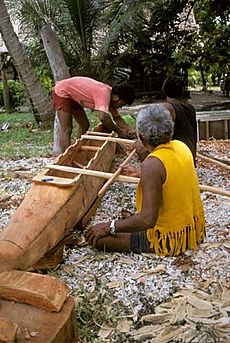
The traditional community system is still strong in Tuvalu. Each family has a special task, or salanga, for the community. This could be fishing, house building, or defense. These skills are passed down from parents to children.
Most islands have a fusi, which are community-owned shops. They are like convenience stores where people can buy canned food and rice. Goods are cheaper, and fusis give better prices for local produce.
Another important building is the falekaupule or maneapa. This is the traditional island meeting hall. Important matters are discussed here, and it is used for weddings and community events like fateles. Falekaupule also refers to the council of elders, who are the traditional decision-makers on each island.
Tuvalu does not have any museums yet, but the government plans to create a Tuvalu National Cultural Centre and Museum.
Traditional Canoes
The Paopao is the traditional single-outrigger canoe of Tuvalu. The largest ones could carry four to six adults. Canoes from Vaitupu and Nanumea were designed for paddling over the reef. Canoes from Nui were built to be sailed over the lagoon. They had longer outrigger booms, making them more stable with a sail.
Sports and Fun
Popular Sports
A traditional sport in Tuvalu is kilikiti, which is similar to cricket. A unique sport to Tuvalu is Ano. It is played with two round balls made from pandanus leaves. Players hit the balls very fast, trying to stop them from touching the ground. This is like a local version of volleyball. In the late 1800s, traditional sports included foot racing, spear throwing, and wrestling.
Today, popular sports in Tuvalu include kilikiti, Ano, football, futsal, volleyball, handball, basketball, and rugby union. Tuvalu has sports organizations for many of these.
At the 2013 Pacific Mini Games, Tuau Lapua Lapua won Tuvalu's first gold medal in an international competition for weightlifting. In 2015, Telupe Iosefa won the first gold medal for Tuvalu at the Pacific Games in powerlifting.
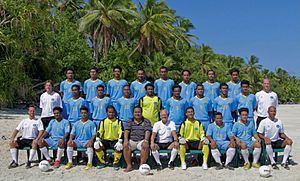
Football is played at club and national team levels. The Tuvalu national football team trains at the Tuvalu Sports Ground in Funafuti. They compete in the Pacific Games. The Tuvalu National Football Association is part of the Oceania Football Confederation (OFC) and hopes to join FIFA.
A big sports event is the "Independence Day Sports Festival" on October 1st each year. The most important sports event in the country is the Tuvalu Games, held yearly since 2008. Tuvalu first took part in the Pacific Games in 1978 and the Commonwealth Games in 1998.
The Tuvalu Association of Sports and National Olympic Committee (TASNOC) was recognized in 2007. Tuvalu first competed in the Olympic Games in 2008 in Beijing, China. They sent a weightlifter and two athletes for the 100-meter sprint.
Economy and Services
Tuvalu's Economy
About 65% of people with formal jobs work for the government. Money sent home by Tuvaluans working in Australia, New Zealand, or as sailors on foreign ships is a big source of income. About 15% of adult men work as sailors. Farming focuses on coconut trees and growing pulaka in large compost pits. Many Tuvaluans also do traditional farming and fishing for their own food.
Tuvaluans are known for their sailing skills. The Tuvalu Maritime Training Institute on Amatuku island trains about 120 marine cadets each year. This helps them get jobs as sailors on merchant ships. The Tuvalu Overseas Seamen's Union (TOSU) is the only trade union in Tuvalu.
The government gets most of its money from selling fishing licenses. It also earns money from the Tuvalu Trust Fund and from leasing its ".tv" Internet domain name. Tuvalu also makes money from postage stamps and its Tuvalu Ship Registry.
The United Nations calls Tuvalu a least developed country. This is because it has limited potential for economic growth, few natural resources, and is small and easily affected by outside economic and environmental changes.
Tourism in Tuvalu
Tourism is not a big industry in Tuvalu because the country is very remote. In 2010, 1,684 people visited Tuvalu. Most were on business, but 20% were tourists. By 2016, the number of visitors grew to 2,000.
Funafuti is where most travelers go because it has the only airport and hotels. However, there are no tour guides or organized activities. Cruise ships do not visit. Some people visit Tuvalu for ecotourism. The Funafuti Conservation Area protects 12.74 square miles (33 square kilometers) of ocean, reef, lagoon, and six uninhabited islets.
You can visit the outer atolls by taking one of two passenger-cargo ships, Nivaga III and Manú Folau. They travel to the outer islands every three or four weeks. Some outer islands have guesthouse accommodations.
Communication and Media
The Tuvalu Media Department runs Radio Tuvalu from Funafuti. In 2011, Japan helped build a new radio studio. This improved equipment allows Radio Tuvalu to be heard on all nine islands. Fenui – news from Tuvalu is a free digital newspaper. It is emailed to subscribers and has a Facebook page with news about the government and Tuvaluan events.
In 2020, the first private newspaper, Tuvalu Paradise News, was launched. The Tuvalu Telecommunications Corporation (TTC) provides phone services to all islands. It also offers mobile phone services on Funafuti, Vaitupu, and Nukulaelae. The TTC also distributes Fiji Television's satellite TV service.
Communications in Tuvalu rely on satellite dishes for phone and internet. The internet speed is limited because many people want to use the service.
Transportation in Tuvalu
Tuvalu has limited transportation. There are about 8 kilometers (5 miles) of roads. The streets in Funafuti were paved in 2002, but other roads are unpaved. Tuvalu does not have any railroads.
Funafuti is the only port, but there is also a deep-water dock in the lagoon at Nukufetau. Tuvalu's merchant fleet has two passenger/cargo ships, Nivaga III and Manu Folau. These ships visit the outer islands every three or four weeks. They also travel between Suva, Fiji, and Funafuti a few times a year. The Manu Folau was a gift from Japan. In 2015, Japan also donated the Nivaga III, which replaced an older ship. In 2020, Tuvalu bought a landing barge called Moeiteava with help from Taiwan. This barge transports dangerous goods and building materials to the outer islands.
The only international airport is Funafuti International Airport. Fiji Airways (Fiji Link) flies to Funafuti three times a week. Air Kiribati also has one flight a week from Tarawa. In 2021, the government plans to start domestic air services to the outer islands. This involves building runways on those islands.
See also
 In Spanish: Tuvalu para niños
In Spanish: Tuvalu para niños




